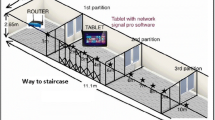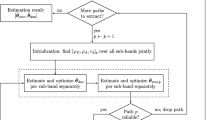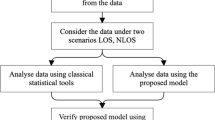Abstract
A robust algorithm based on Twin Support Vector Regression and discrete wavelet transform applied to millimetric wave (mmWave) channel prediction is proposed in this work. The 60 GHz band is appropriate for small-scale high-speed data transmission applications in future 5G indoor network solutions. The experimentation takes place in an enclosed complex conference room setting with furniture and computer equipment. The proposed algorithm is applied to mmWave multipath channel with higher order modulation scheme with receiver sensitivity thresholds being − 80 dBm, − 90 dBm, − 100 dBm and − 110 dBm corresponding to 41, 89, 195 and 250 paths, respectively. The Channel Impulse Response of 60 GHz multipath wireless system is generated by the “Wireless InSite” ray tracer by Remcom. Compared to other traditional algorithms, numeric experiments confirm the effectiveness of the proposed solution under several multipath configurations.








Similar content being viewed by others
References
Li, S., Liu, Y., Lin, L., Sun, D., Yang, S., & Sun, X. (2018). Simulation and modeling of millimeter-wave channel at 60 GHz in indoor environment for 5G wireless communication system. In ICCEM (pp. 1–3).
Liu, P., Di Renzo, M., & Springer, A. (2017). Variable-\(N_{u}\) generalized spatial modulation for indoor LOS mmWave communication. IEEE Transactions on Communications, 65(6), 2625–2640.
Fan, Y., Zhang, Z., & Li, H. (2019). Message passing based distributed learning for joint resource allocation in millimeter wave heterogeneous networks. IEEE Transactions on Wireless Communications, 18(15), 2872–2885.
Rappaport, T., et al. (2013). Millimeter-wave mobile communications for 5G cellular: It will work! IEEE Access, 1, 335–349.
Vehmas, J., Jarvelainen, J., Nguyen, S., Naderpour, R., & Haneda, K. (2016). Millimeter-wave channel characterization at Helsinki airport in the 15, 28, and 60 GHz bands. IEEE Access, 1–5.
Zhou, P., Cheng, K., Han, X., Fang, X., Fang, Y., He, R., Long, Y., & Liu, Y. (2018). IEEE 802.11ay based mmWave WLANs: Design, challenges and solutions. IEEE Communications Surveys Tutorials, 20(3), 1–28.
Al-Falahy, N., & Alani, O. (2019). Millimetre wave frequency band as a candidate spectrum for 5G network architecture: A survey. Physical Communication, 32(1), 120–144.
Liu, P., Di Renzo, M., & Springer, A. (2016). Line-of-sight spatial modulation for indoor mmWave communication at 60 GHz. IEEE Transactions on Wireless Communications, 15(11), 7373–7389.
Liu, P., Blumenstein, J., Perovic, N., Di Renzo, M., & Springer, A. (2018). Performance of generalized spatial modulation MIMO over measured 60 GHz indoor channels. IEEE Transactions on Communications, 66(1), 133–148.
Ericsson. (2019). Bringing 5G Networks Indoors. [online]. https://www.ericsson.com/en/reports-and-papers/white-papers/bringing-5g-networks-indoors/. Accessed: 02 November 20.
Sengupta, A., Alvarino, A., Catovic, A., & Casaccia, L. (2020). Cellular terrestrial broadcast-physical layer evolution from 3GPP release 9 to release 16. IEEE Transactions on Broadcasting, 1–12.
Chang, S. (2020). An emergence alert broadcast based on cluster diversity for autonomous vehicles in indoor environments. IEEE Access, 1–4.
Idrees, N., Yu, X., & Springer, A. (2019). Optimal tracking of doubly-selective radio channels for OFDM based modern wireless systems. Physical Communication, 35, 13–21.
Neumann, D., Wiese, T., & Utschick, W. (2018). Learning the MMSE channel estimator. IEEE Transactions on Signal Processing, 66(11), 2601–2613.
Gu, F., Fan, Y., Wang, L., Tan, X., & Wei, J. (2019). A universal channel estimation algorithm based on DFT smoothing filtering. IEEE Access, 7, 33–39.
Zhang, M., Zhou, X., & Wang, C. (2019). A novel noise suppression channel estimation method based on adaptive weighted averaging for OFDM systems. Symmetry, 11(8), 33–42.
Wu, Q., Zhang, H., Jing, R., & Li, Y. (2019). Feature selection based on twin support vector regression. In 2019 IEEE symposium series on computational intelligence (SSCI) (pp. 2903–2907).
Melki, G., Cano, A., Kecman, V., & Ventura, S. (2017). Multi-target support vector regression via correlation regressor chains. Information Sciences, 415–416, 53–69.
Anand, P., Rastogi, R., & Chandra, S. (2019). A new asymmetric \(\epsilon\)-insensitive pinball loss function based support vector quantile regression model. arXiv:1908.06923.
Balasundaram, S., & Meena, Y. (2016). A new approach for training Lagrangian support vector regression. Knowledge and Information Systems, 49(1), 1097–1129.
Balasundaram, S., & Meena, Y. (2014). K-nearest neighbor-based weighted twin support vector regression. Applied Intelligence, 41(1), 299–309.
Charrada, A., & Samet, A. (2020). Twin Support vector regression for complex millimetric wave propagation environment. Heliyon, 6(11), E05369.
Tehrani Moayyed, M. Channel impulse response for mmWave communication. https://www.github.com/NEU-MathWorks-mmWaveProject/Channel-Impulse-Response, GitHub. Retrieved May 12, 2020.
Ortega, L., & Khashanah, K. (2014). A neuro-wavelet model for the short-term forecasting of high frequency time series of stock returns. Journal of Forecasting, 33(1), 33–44.
Charrada, A., & Samet, A. (2012). Estimation of highly selective channels for OFDM system by complex least squares support vector machines. International Journal of Electronics and Communications (AEU), 66, 687–692.
Author information
Authors and Affiliations
Corresponding author
Ethics declarations
Conflict of interest
The authors declare that they have no known competing financial interests or personal relationships that could have appeared to influence the work reported in this paper.
Additional information
Publisher's Note
Springer Nature remains neutral with regard to jurisdictional claims in published maps and institutional affiliations.
Rights and permissions
About this article
Cite this article
Charrada, A., Samet, A. Application of TSVR algorithm in 5G mmWave indoor networks. Wireless Netw 27, 1491–1502 (2021). https://doi.org/10.1007/s11276-020-02538-2
Accepted:
Published:
Issue Date:
DOI: https://doi.org/10.1007/s11276-020-02538-2




